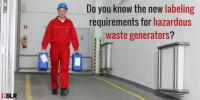The final Hazardous Waste Generator Improvements Rule (Rule), published in the Federal Register on November 28, 2016, contains two of what the U.S. Environmental Protection Agency (EPA) refers to as “voluntary programs”—meaning that generators of hazardous waste have the choice of whether to comply with the new programs’ requirements. The first program is a set […]
Q. Because of removing excess chemical inventories one month this year, I changed from being a small quantity generator (SQG) to a large quantity generator (LQG). Which set of requirements should I comply with and for how long?
Do you know what new requirements have been finalized under the Hazardous Waste Generator Improvements Rule? This infographic provides a view into what will be in store soon for all classes of hazardous waste generators.
Q. Can a cell phone be used to meet the communication device requirement for LQG 90 day areas?
The Hazardous Waste Generator Improvements Rule (Rule), finalized on October 28, 2016, will require hazardous waste large quantity generators (LQGs) and small quantity generators (SQGs) to make many changes as to how they manage their hazardous waste. Because the current generator requirements will be in place in most states for months and months to come—that […]
As frequent visitors to EPA’s Resource Conservation and Recovery Act (RCRA) Online database already know, the Agency’s hazardous waste regulations prompt a constant stream of questions from both regulated entities and RCRA-authorized states about applicability, lack of clarity, and regulatory gaps. A small fraction of EPA’s answers and interpretations responding to such questions have now […]
In a final rule, the EPA has overhauled its regulations governing U.S. import and export of hazardous waste. One intent of the rule is to make EPA’s import/export provisions more consistent with import/export standards followed by members of the Organisation for Economic Co-operation and Development (OECD). The EPA also says the revisions respond to a […]
EPA’s Test Methods for Evaluating Solid Waste, Physical/Chemical Methods, also known as SW-846, is the Agency’s official compendium of methods for use in complying with Resource Conservation and Recovery Act (RCRA) regulations. SW-846 comprises over 200 analytical methods for sampling and analyzing waste and other matrices. Most methods are intended as guidance (i.e., nonregulatory or […]
Generators of hazardous waste that meet the current Resource Conservation and Recovery Act (RCRA) standards for being conditionally exempt small quantity generators (CESQGs) will be “rebranded” as “very small quantity generators” (VSQGs) when the proposed Hazardous Waste Generator Improvements Rule (Rule) is finalized (most likely this month). Whether such generators are called CESQGs or VSQGs, […]
Q. Can a Hazardous Waste determination be made for dust waste using only the Kst value (ASTM Standard Test Method E 1226)?










